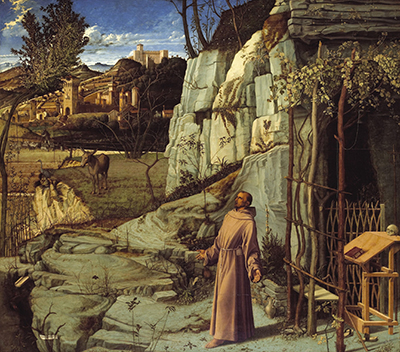St Francis in Ecstasy (or St Francis in the Desert as it is sometimes known) is a large painting from Giovanni Bellini which was completed in circa 1480 using the trademark oils that this artist preferred to use over the normal choice of egg tempera within Renaissance Italy.
Francis of Assisi was an Italian saint from the 12th century who lived much of his life in relatively impoverished conditions. That said, the content in the piece should not be considered an accurate representation of his life, but more a symbolic depiction using the artist's creative licence. Bellini puts several animals within this painting which point towards the saint's known love of nature but he also did so in many of his other paintings, too. See the hare within Christ Blessing, for example.
This painting is a part of the Frick Collection in New York City and can be considered one of their most prominent pieces. Henry Clay Frick was a wealthy industrialist with a passion for collecting art and many of the pieces in this museum would have been on display with his own house during his lifetime. As often occurs when art collectors pass away, their entire collection is left to the public so that as many others can enjoy them as possible.
In 1595 there was another version of this theme created by the extraordinary Caravaggio, named Saint Francis of Assisi in Ecstasy. This artist was unique in his approach to light, creating dramatic scenes which reflected his equally excessive behaviour and personality. Whilst tackling the same theme, Caravaggio and Bellini deliver two very different depictions, underlining the importance of creativity and style within the Renaissance and Baroque movements, even though they would often tackle similar topics within their work. Additionally, there was also a version produced by El Greco in 1600.




